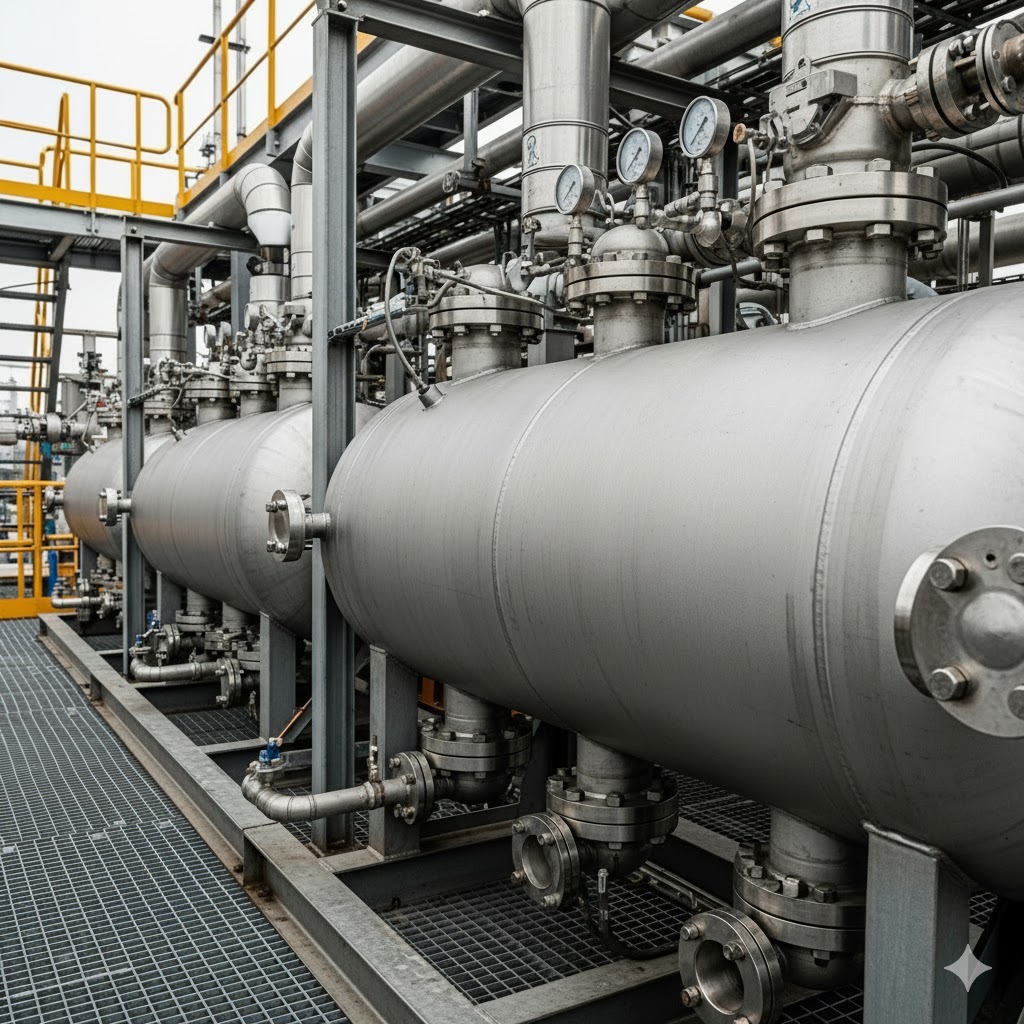Dry Gas Filters for LNG Facilities: Ensuring Purity and Performance
Executive Summary
Liquefied Natural Gas (LNG) facilities rely on operational precision. Any contaminants in feed gas, whether dust, rust, or fine particulates, can lead to turbine damage, catalyst poisoning, and costly downtime. Dry gas filtration is a frontline safeguard, ensuring that LNG plants maintain gas purity, meet environmental regulations, and optimize overall performance. This paper explores the role of dry gas filters in LNG applications, the risks of inadequate filtration, and the strategies to ensure long-term reliability and cost efficiency.
The LNG Challenge: Why Purity Matters
Natural gas must be exceptionally clean before liquefaction. Even microscopic solids can create significant problems:
- Compressor & turbine erosion: Solid particles accelerate wear, leading to reduced efficiency and unplanned outages.
- Cryogenic exchanger fouling: Impurities can block passages, reduce heat transfer, and decrease liquefaction efficiency.
- Catalyst degradation: Trace solids may deactivate catalysts in pre-treatment units, increasing replacement costs.

In LNG facilities, where uptime and reliability directly impact global energy supply contracts, these risks translate into millions of dollars in potential losses.
Dry Gas Filters: The First Line of Defense
Dry gas filters are designed specifically to remove solid particulate matter from natural gas streams. Unlike scrubbers or coalescing filters, which focus on liquid removal, dry gas filters target solids such as:
- Pipeline rust and scale
- Black powder (iron sulfide, iron oxide, silica)
- Weld slag and mill scale introduced during construction or maintenance
- Dust and sand entrained in upstream systems
By capturing these solids before they reach sensitive LNG equipment, dry gas filters safeguard the plant’s performance and longevity.
Technical Considerations for LNG Applications
Designing and implementing dry gas filters for LNG facilities involves several critical technical factors:
- Filtration Efficiency: High-efficiency cartridges can remove particles down to 0.3 microns. API 614 and ISO standards provide benchmarks for acceptable levels of particulate carryover
- Pressure Drop Management: Filters must balance high capture efficiency with minimal pressure drop to avoid reducing throughput. Multi-cartridge housings are often used to handle LNG-scale flow rates.
- Materials of Construction: Carbon steel with epoxy coatings is common, but stainless steel may be required in cryogenic or corrosive environments. Seals and gaskets must withstand both cryogenic temperatures and high operating pressures
- System Integration: Placement upstream of compressors and cryogenic exchangers ensures maximum protection. Skid-mounted modular units allow for easier maintenance in LNG plants with high throughput demands.
Case in Point: LNG Plant Reliability Gains
In one midstream LNG export facility, operators reported:
- A 35% reduction in unplanned turbine shutdowns after upgrading to high-efficiency dry gas filters.
- Extended filter change intervals by 40% due to optimized housing design and improved filtration media.
- Savings of over $2.5 million annually in avoided downtime and equipment repairs.
This illustrates the tangible ROI of proper filtration strategy in LNG operations.
Best Practices for LNG Facilities
- Conduct particle size distribution analysis to understand contamination sources.
- Right-size filters to handle LNG-scale volumes without excessive pressure loss.
- Adopt multi-stage filtration (dry gas filters + coalescers) to remove both solids and liquids.
- Monitor differential pressure across filters for predictive maintenance.
- Work with OEM-certified suppliers to ensure compliance with API/ASME standards.
The Bigger Picture: Operational and Environmental Value
Beyond equipment protection, dry gas filtration also plays a role in:
- Sustainability: Cleaner gas reduces emissions from incomplete combustion.
- Contract compliance: LNG export contracts often specify maximum allowable contaminants
- Safety: Reducing particle-related failures lowers the risk of operational hazards.
Conclusion
In LNG facilities, where uptime and efficiency are paramount, dry gas filters are not optional—they are mission-critical. By investing in the right filtration technology, operators not only safeguard their assets but also improve reliability, reduce environmental impact, and protect multi-billion-dollar LNG supply commitments.